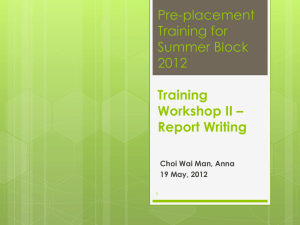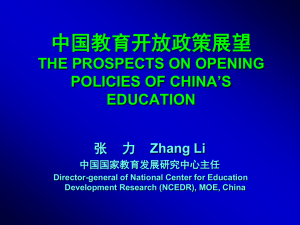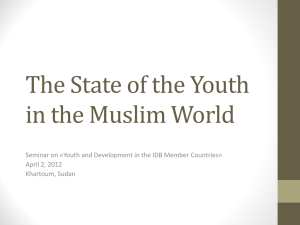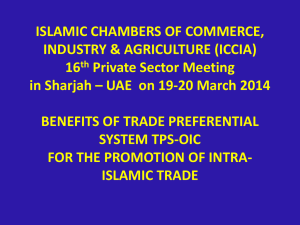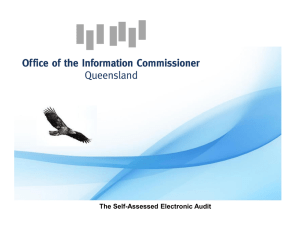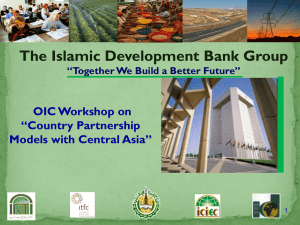"Task Force for OIC Capital Market Linkages" and the
advertisement
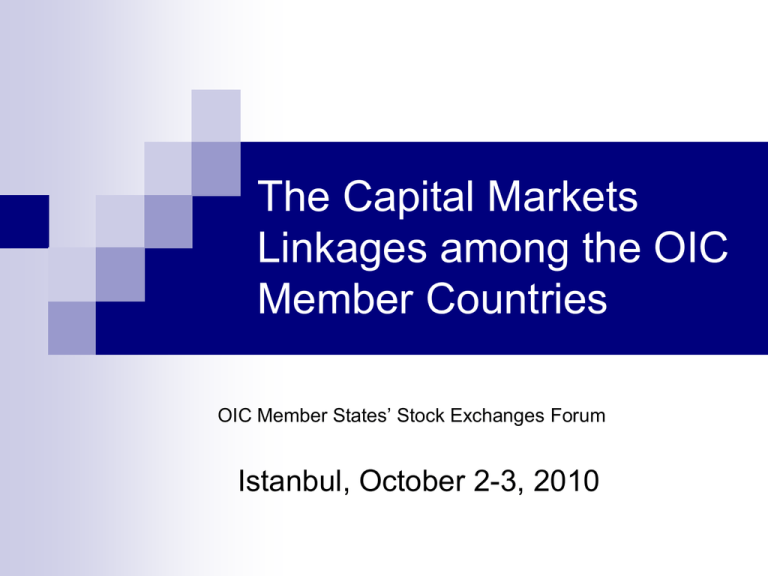
The Capital Markets Linkages among the OIC Member Countries OIC Member States’ Stock Exchanges Forum Istanbul, October 2-3, 2010 Joint Work by the Capital Markets Linkages and Post-Trade Services Task Forces At the last Working Committee meeting held in Abu Dhabi, a decision has been taken for “an inter-committee meeting to be held between the task forces for the OIC Capital Markets Linkages and Post-trade Services with regards to the work carried out on linkages.” With regard to this decision, both Task Forces worked together and prepared this joint work, including a guideline on how to establish a cross-trading environment among the OIC member countries. 2 Necessitates of Exchanges Linkages Liquidity is one of the most essential elements for a strong link between stock markets. Possible benefits associated with regional integration of exchanges are: Diversified risk in a wider market ; More efficient and competitive markets ; lower costs and higher returns ; Increased cross-border capital flows ; Pooling the resources of fragmented capital markets could boost liquidity and the ability of these markets to mobilize local and international capital for development ; Investors would gain access to a broader range of shares; Issuers would gain access to a larger number of investors, and Reduction of the risk of market volatility due to increase in the size of the markets. 3 Goal and Scope of the Capital Markets Linkage To provide local investors in the OIC Member Countries with easy access to other OIC members’ capital markets in terms of operational efficiency, cost effectiveness, advanced technological and safe environment To build a common understanding of market linkages in the OIC Member Countries’ stock exchanges To overcome barriers impeding to invest in the OIC capital markets To create awareness among the OIC Member Countries on benefits and costs of market linkages 4 Some Models of linkages among Capital Markets CME Group and BM&Bovespa (iLink) LATIBEX (among Five Latin America Countries Link up Markets (among 10 leading CSDs spread from Europe to South Africa ADX Linkage with DFM and MSM ASEAN Trading Link Eurex, the International Securities Exchange (ISE), and The Options Clearing Corporation (OCC) 5 Results of the Questionnaire I (made by the Post-Trade Services Task Force) To explore intentions and possibilities for establishing market linkages among stock exchanges and post-trading institutions in the OIC member countries Replying institutions Abu Dhabi Stock Exchange Amman Stock Exchange Beirut Stock Exchange Bursa Malaysia Central Registry Agency, Turkey Egypt Stock Exchange Istanbul Stock Exchange Kyrgyz Stock Exchange MCSD, Egypt Tadawul Stock Exchange Takasbank, Turkey Tehran Stock Exchange 6 Results of the Questionnaire I (made by the Post-Trade Services Task Force) All the replying members denoted that; Their investors have interest for investing in other OIC member states’ capital markets. A market access to other OIC member states’ capital markets would attract their investors. They have intentions to establish capital market linkages and/or correspondent relationships with the other OIC member states’ capital market institutions. Some members stated that there are some barriers to establish a link/relationship with the correspondent institutions operating in OIC member states. 7 Results of the Questionnaire I (made by the Post-Trade Services Task Force) Current direct links (only for members replied the questionnaire) Current correspondent accounts (only for members replied the questionnaire) Abu Dhabi SE -DFM Egypt SE - London SE MCSD – SIS Swiss Clearing, Link-up Markets Europe Takasbank – Euroclear MCSD – El Kuwait, Mid Clear Current MoUs (only for members replied the questionnaire) Among Stock Exchanges Among Post Trade Instititutions 8 Current Linkage Models I Asean Link DFM/ADX/MSM Link iLink Members Thailand, Singapore, Malaysia, the Philippines, Indonesia, Vietnam Dubai, Abu Dhabi, Muscat CME, BM&FBOVESPA Legal Status Exchanges remain as independant legal entities Exchanges remain as independant legal entities Exchanges remain as independant legal entities Infrastructure Management Independent (third party) Not independent (jointly managed) Not independent (jointly managed) Local regulations Local regulations Local regulations Home country clearing houses Home country clearing houses Home country clearing houses Local brokerage houses Local brokerage houses Local brokerage houses Regulations Settlement and Custody Brokers 9 Current Linkage Models II Asean Link DFM/ADX/MSM Link iLink Trading securities 30 blue-chip stocks from each exchange will form the “Asean Bulletin Board”. All stocks Derivatives products Listing securities Home country exchange rule Home country exchange rule Home country exchange rule No need No need No need n.a Brokerage firms receive an amount eq. to 10% of the fees (exchange and registration fees) on the executed trades Full Harmonisation Incentives n.a. 10 Current Linkage Models III Asean Link DFM/ADX/MSM Link iLink Order Routing Yes Yes Yes Direct Market Access Yes Yes Yes Algoritmic trading n.a. n.a. Yes 11 Results of the Questionnaire II (Made by the OIC Capital Market Linkage Task Force) To discover opinions of OIC member countries stock exchanges and posttrading institutions for establishing market linkages Replying Exchanges: Amman Stock Exchange Istanbul Stock Exchange Palestine Exchange Kyrgyz Stock Exchange Tadawul Stock Exchange Tehran Stock Exchange 12 Results of the Questionnaire II (Made by the OIC Capital Market Linkage Task Force) The main points that can be extracted from the replying exchanges are: Almost all of replying exchanges have DMA capabilities. DMA is a prerequisite and infrastructure for any international trading linkages. There is no restriction for foreign ownership specially strategic ownership except for Kyrgyz in strategic ownership and Saudi Arabia that impose some restriction on non GCC investors. Most of replying exchanges announced that currently, they don’t have a trading linkage but may set a plan for joining to a market link in the future. There is no restriction (such as repatriation of principle and profit) on foreign investment by the replying members except Tadawul, even some of them offer encourages to attract foreign investors. Almost all of replying exchanges have a desirable capabilities in the data dissemination through their web site or the data vendors. 13 Results of the Questionnaire II (Made by the OIC Capital Market Linkage Task Force) Tadawul Restriction on foreign investment Tax on foreign investors Current trading link Market cap belong to foreign investors Strategic investment allowed to foreign investors Amman restriction on Some restriction some sectors on non Saudi and companies no no Tehran Palestine Istanbul Kyrgyz no no no no no no no no no no no no no No but there is a cross listing agreement with Kazakhstan 2% 48.6% 5% 45% 67% of free float N/A Yes Yes Yes Yes Yes no 14 Results of the Questionnaire II (Made by the OIC Capital Market Linkage Task Force) Tadawul Holding threshold foreign investors Trading system DMA 49% Amman For some companies Tehran 20% NASDAQ OMX NSC V900 NYSE ATOS Euronext system Euronext Yes Yes Yes – has this capabilities Data disclosure Yes – Free Yes – Free through through Yes – Free data through vendors or exchange web vendors exchange web exchange site site Palestine no HORIZON NASDAQ OMX Yes Yes - Free Istanbul Kyrgyz No but it is depend on companies article of association In house developed electronic system In house developed electronic system no Yes no Yes – Free in Yes – Free but the process of plan to be sold signing through data agreement with vendors Bloomberg 15 Results of the Questionnaire II (Made by the OIC Capital Market Linkage Task Force) Clearance Tadawul Amman Tehran Palestine Istanbul Kyrgyz T+0 T+2 T+3 T+3 T+3 T+3 no no No plans so far Currently no plan N/A no no Plans for launch a May be in the trading linkage future Special rule for international link no no no no No predetermined rule Regulatory body permission Yes Yes Yes Yes Yes 16 Main Specifications of the Proposed Model Country X Stock Exchange X Investor X through brokerage house X Brokerage House X Order router Risk management Once the participant identified, the order is submitted to risk analysis, conducted by Brokerage House Y Gateway Country Y 1 Stock Exchange Y Investor Y through a brokerage house Agreement The order routing system recognizes that it is an order related to the Stock Exchange Y market and routes it to the Stock Exchange Y 2 Brokerage House Y Order book 1 (copy sent to the brokerage house) Having passed the risk criteria, the order is included in the order book Clearing&Settlement Brokerage House X signs an agreement with a brokerage house from Country Y, all trades via the e-link is cleared&settled through Brokerage House Y. 17 Main Specifications of the Proposed Model (continued) In the proposed model based on order-routing system, every exchange continues to operate on its own trading and post-trading systems. Current exchanges will be linked to each other through electronic linkages. Local brokerage houses track the other exchanges via a single board/screen and trade directly through e-links, as if trading in their local exchanges. Currently effective licensing, trading and settlement mechanisms continue to be in force. Stocks are traded on the home country exchanges where they are listed on single order book. This would not cause any liquidity loss. 18 Main Specifications of the Proposed Model (continued) It provides market access to the home country exchange for foreign brokerage houses No cross-membership is required Bilateral Agreements among intermediaries have a vital role. For this reason, the requirements of brokerage firms should be clarified and addressed. Regulatory authorities and exchanges keep their enforcement power and status. Each participant is subject to its own regulations. It does not cause any conflict of interest among exchanges because of independent management structure. 19 Main Specifications of the Proposed Model (cont’d) In the proposed model, No changes to the current set-up and no need for a new system development for the post trade services Local brokerage house signs an agreement with a brokerage house which is a member of another OIC member stock exchange in which the trade is executed Local brokerage house executes clearing & settlement of all its trades in that exchange through bilaterally agreed brokerage house Easy Implementation with minimal adaptation Potential future extensions; Opening bilateral correspondent accounts between CSDs would facilitate more efficient post trade operations Setting up a linkage among CSDs in order to provide market participants with a single point for access 20 Issues to be considered Regulation Barriers International capital flows Trading rules Post-trading infrastructure Risk management Public disclosure Taxation Bilateral agreements among the intermediaries Technological Infrastructure Capital market institutions` adequacy (order-routing capability) Availability of efficient telecommunication services 21 Issues to be considered (cont’d) Financing Costs Software Data dissemination Consulting services Marketing Sources of funding Member exchanges Post-trade institutions Intermediary institutions Multilateral institutions (Islamic Development Bank etc.) 22 Strategic View Electronic links may first be established between the relatively developed exchanges, and then could be expanded by the participation of the other OIC members’ stock exchanges. Each participant exchange is expected to allow blue-chip stocks to be traded through this platform. The list of selected stocks could be made available on data vendors, preferably in real-time. The management of the IT infrastructure should be carried out by an independent technology provider. It is of crucial importance to have the long-term perspective and to take the key steps towards such closer types of cooperations, which will serve the global presence, awareness and competitiveness of OIC capital markets. 23 The Way Forward To make feasibility studies on issues to be considered for the proposed model Marketing To determine dedicated candidates to work for the feasibility studies To include IT people into the feasibility studies To hold regular task force meetings to enforce the members` attendance to create an e-mail group To take consultancy services To organise “Capital Markets Linkages Conference” in 2011 To organise an OIC Fair/Convention Companies - top 10 Capital market institutions Technology providers Institutional investors Signing MOU among OIC Member Countries` stock exchanges and related institutions encourages and enables them to persuade the project. 24 Signing a MOU Signing a MOU among the interested exchanges outlines their commitment to persuade the mutual cooperations that focus on designing, testing and implementing the suggested E-Trading link. Some General Guiding Principles that can be included in the proposed MOU are: Exchanges shall act and conclude on the agreement by their good will and based on their governing rules and regulations. Exchanges will subsequently encourage and guide their brokers for concluding bilateral or multilateral agreements to facilitate retail or institutional investment in the foreign exchange. 25 Signing a MOU (cont’d) Exchanges, with due diligence, shall act for implementation of the agreement and smoothing the ground to expedite launching of the OIC Capital Market Linkage. The agreement is considered as an object for expanding the cooperation and transparency of the exchanges' measures, as well as a way to tackle the barriers in front of investors and brokers to participate in the OIC Capital Market Linkage. 26
